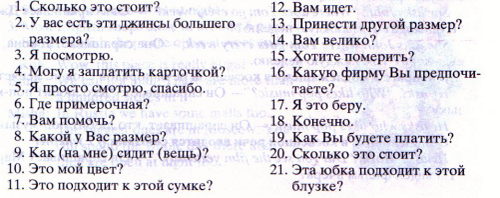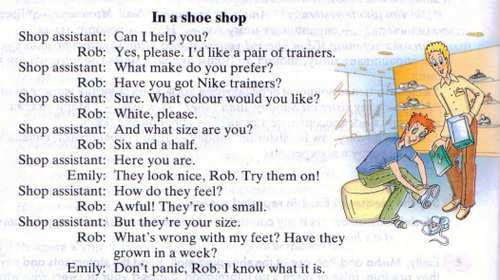- Учителю
- Обучение диалогической речи индуктивным и дедуктивным способами на тему 'Покупка одежды' (9 класс)
Обучение диалогической речи индуктивным и дедуктивным способами на тему 'Покупка одежды' (9 класс)
Обучение диалогической речи индуктивным способом
-
Введение и первичное закрепление лексического материала
T: Today we are going to speak about shopping. Look at these words and explain their meaning: A shop assistant and a customer (слова написаны на доске)
Ss: A shop assistant is a person who sells different goods. A customer is a person who buys something.
T: Well, listen to the following sentences which you need when you want to buy clothes and repeat them after the speaker:

T: Well done! Now try to match these expressions and their translations:

T: Good. Let's check your answers. We are beginning with the first row, one by one.
Ss: читают и переводят выражения по цепочке.
T: Right. Then do a table in your workbooks with two sections: one for a shop assistant and another for a customer. Write down the shop assistant's phrases and customer's ones into the table, please.
Ss: записывают фразы в таблицу.
T: Work in pairs. Make up as many mini-dialogues as you can with these sentences. You can use some sentences more than once.
Ss: Customer: Do you need another size? It's too big on me.
Shop assistant: Sure, it's no problem.
T: Good! Now imagine that you're in the shop of clothes and you need to buy a dress or trousers. Make up your dialogues in pairs, please.
Обучение диалогической речи дедуктивным способом
T: Today we are going to speak about shopping of clothes and shoes. In pairs read this dialogue and translate it, please.
Ss: читают диалог
T: Ok. Let's read the dialogue for detail aloud. Please Masha and Petya, begin.
T: Who knows what is happened?
Ss: Russian and American sizes are different.
T: Right. Look at the table with Russian and American sizes and compare them.
When you talk about clothes sizes what expressions can you change in the dialogue?
Ss: a pair of trainers, six and a half, colour, and a trade mark.
T: What words can you use for replacing these words?
Ss: a dress, a skirt, jeans, wellingtons etc.
T: Great! Now using the size table, make up the similar dialogue with your partner and complete it with the other way, please.